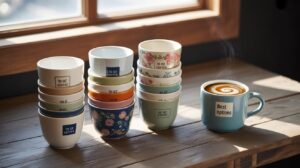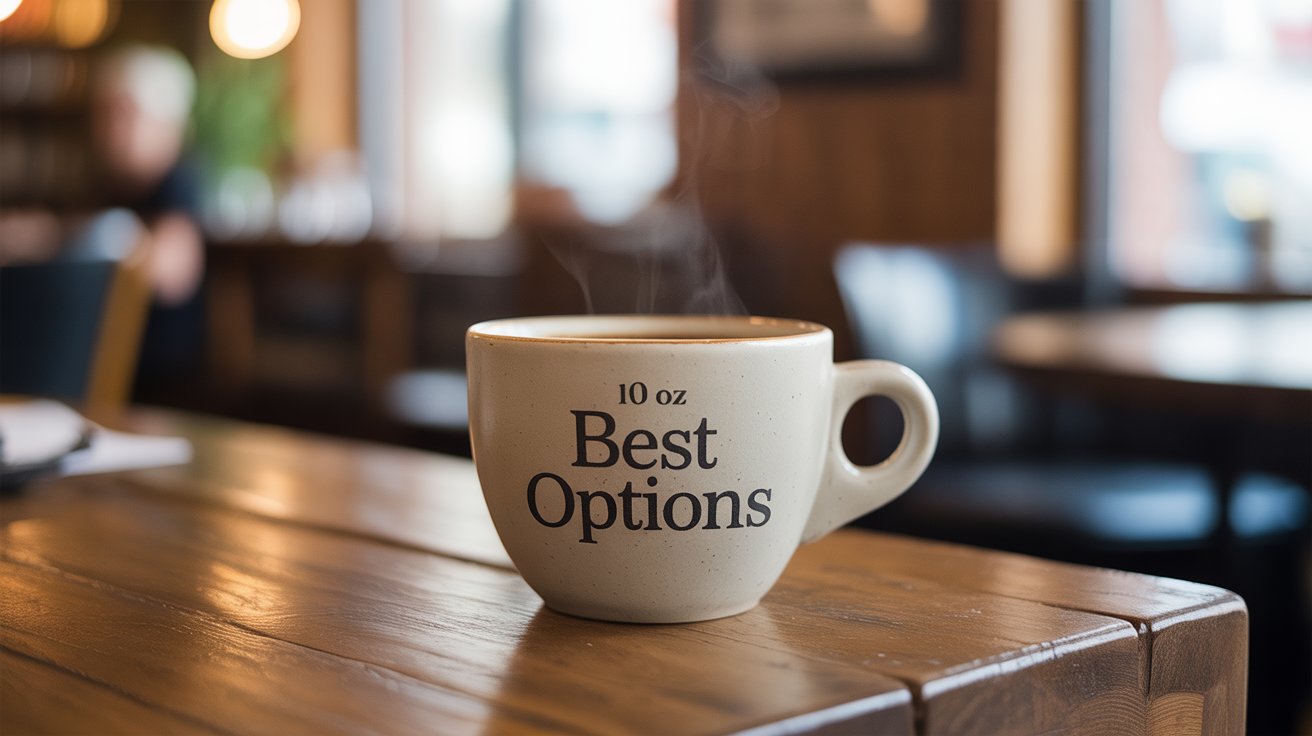Looking for the best 10 oz coffee cups review to know which ones actually hold up? You’re not alone—most people discover too late that half the options out there leak, collapse, or can’t even handle a hot latte.
I’ve tested, compared, and sifted through the noise so you don’t waste money on flimsy cups that ruin your coffee break. In this guide, you’ll see which 10 oz cups are durable, eco-friendly, and worth buying—and which ones you should skip.
Because whether you’re stocking a café, running an office, or just want a reliable morning cup, choosing the right 10 oz coffee cup makes all the difference.
What Are 10 oz Coffee Cups—and Who Needs Them?
A 10 oz coffee cup is that “just right” size between the too-small 8 oz and the oversized 12–16 oz giants. It holds enough for a full pour-over or latte without feeling wasteful or heavy in your hand.
Cafés often use this size for cappuccinos, flat whites, or small drip coffees. Offices stock them because they balance portion control with employee satisfaction (nobody likes cold half-drunk coffee sitting on a desk). And sustainability-minded consumers lean on 10 oz because smaller servings often mean less waste, fewer refills, and a lower environmental footprint.
If you’ve ever wrestled with whether to grab the 8 oz or 12 oz at Starbucks, you’ve already felt the value of this middle ground. In fact, many independent coffee shops worldwide—especially in Melbourne and Seattle—default to 10 oz mugs for milk-based espresso drinks.
Read Also:
Why 10 oz Cups? Key Benefits & Use Cases
Choosing 10 oz cups isn’t about the number on the label. It’s about how that size fits real drinking habits.
Ideal volumes for popular drinks:
Lattes & Cappuccinos: Enough room for espresso plus silky microfoam without drowning it.
Drip Coffee: A “short” serving that stays hot until the last sip.
Specialty Teas: Works perfectly for herbal blends like ginger-peach or chamomile that don’t need a bucket-sized mug.
Reduced waste vs larger cups:
Studies show that Americans throw out over 120 billion disposable cups annually (EPA, 2023). Downsizing from 12–16 oz to 10 oz reduces material use and leftover liquid waste.
Smaller servings help cafés save on milk costs while encouraging customers to finish every drop—critical for high-volume shops.
Eco-conscious contexts where 10 oz shines:
Events: Festivals, conferences, weddings—where portion control + waste reduction matter.
To-go orders: Easier to carry, better lid fit, less spill risk compared to taller cups.
Households: Ideal for families who brew multiple small cups instead of mega-mugs.
Think of 10 oz cups as the “MacBook Air” of coffeeware: light, versatile, and exactly what most people need—even if bigger options exist.
Pros & Cons of 10 oz Coffee Cups

Before you click “buy now,” it pays to weigh the upsides and trade-offs of 10 oz coffee cups. This is where most buyers either save money and reduce waste—or end up frustrated with cups that don’t fit their actual needs.
Pros
Less waste, more control: A 10 oz pour cuts down leftover coffee and milk waste compared to 12–16 oz cups. Many cafés in Seattle and Melbourne now use this size as a standard for milk-based drinks.
Comfortable handling: Shorter height = better grip. You don’t need two hands or a death grip to keep your drink steady.
Cheaper in bulk: Amazon bulk packs like GUSTO’s 100-count white paper cups often cost pennies per cup—ideal for offices or events.
Lid compatibility: Most 10 oz cups are built for standard 90 mm lids, the same size many 12 oz cups use. That means fewer lid SKUs for cafés or event planners.
Cons
Smaller size isn’t for everyone: If your customers expect “grande” servings, a 10 oz might feel stingy.
Varied insulation: Single-wall paper cups often need sleeves. Without them, you risk scorched fingers.
Composting challenges: Unless the cup carries a BPI-certified compostable or FSC-certified label, it may end up in landfill despite being “paper.”
Comparison Table: Top 10 oz Cup Options
Here’s a side-by-side look at some of the most popular 10 oz cups available online. Use this table as your shortcut to compare materials, certifications, price, and eco credentials before deciding.
| Brand / Product | Material | Certifications | Price per Unit* | Heat / Insulation | Lid Compatibility | Eco Score |
|---|---|---|---|---|---|---|
| GUSTO 10 oz White Paper Cups (Amazon) | Paper, single-wall | None listed | ~$0.09 | Basic, sleeve recommended | Standard 90 mm | ⭐⭐ (Landfill only) |
| LollicupStore Karat 10 oz Paper Hot Cups | Poly-lined paper | FDA Compliant | ~$0.07 (bulk 1,000) | Decent, sleeve optional | Standard 90 mm | ⭐⭐ (Not compostable) |
| World Centric 10 oz Compostable Paper Cups | PLA-lined paper | BPI®, FSC® | ~$0.12 | Good heat retention | Standard 90 mm | ⭐⭐⭐⭐⭐ (Commercial compostable) |
| Reusable Ceramic Mug (Generic 10 oz) | Ceramic | N/A | One-time purchase ~$8–12 | Excellent, natural insulation | No lid | ⭐⭐⭐⭐ (Reusable, long life) |
*Prices vary by supplier and bulk quantity.
Pro tip: If you run a café or office, start with compostable PLA-lined cups like World Centric. They cost slightly more upfront but pay off in eco-credibility and customer loyalty. If you’re shopping for home use, a reusable ceramic mug beats disposables within a month of daily coffee habits.
Deep-Dive Review: Best 10 oz Cups in 2025

If you’re shopping for 10 oz coffee cups in 2025, the field splits into two clear camps: budget disposables and eco-friendly upgrades. Below, I’ll break down the most reliable options based on durability, insulation, and sustainability—so you can skip the trial-and-error.
GUSTO White Paper Cups (100-count, Amazon)
For offices and events, GUSTO’s 10 oz cups remain a bestseller.
Key features: Heat-resistant design, smooth exterior for easy branding, and a professional “FSC-certified look” even though they don’t carry certification.
Best use case: Short meetings, catered events, or quick-service cafés that need a clean, uniform look at a low cost.
Watch out for: They’re single-wall. If you’re serving piping hot lattes, you’ll need sleeves.
Karat Paper Hot Cups (LollicupStore)
Karat by Lollicup is a staple in cafés across Los Angeles and New York.
Key features: Double poly-lined walls, FDA-compliant paperboard, and tight compatibility with Karat 90 mm lids.
Best use case: Busy coffee shops that need reliability for milk-based drinks or americanos.
Watch out for: These aren’t compostable. Disposal is landfill-only unless you have a recycling stream for poly-lined cups.
World Centric Compostable PLA Cups
This is the option for cafés chasing sustainability credibility.
Key features: Lined with plant-based PLA, BPI- and FSC-certified, and commercially compostable.
Best use case: Third-wave coffee shops in eco-conscious markets like Portland or San Francisco. Customers notice—and care.
Watch out for: They cost more (around $0.12 per unit) and require access to a commercial composting facility.
Alternatives to Disposable 10 oz Cups
Not everyone wants to keep buying sleeves of paper cups. For home drinkers and sustainability-minded professionals, reusables are the smarter play.
Reusable Ceramic & Metal Mugs
Editorial darlings like the Haand 10 oz ceramic mug (praised by Bon Appétit and Epicurious) or the Ember temperature-control mug (Serious Eats favorite) add both style and function.
Ceramic: Perfect for home rituals. Thick walls keep drinks warmer without extra insulation.
Smart mugs: Ember’s 10 oz keeps coffee at 135°F for hours. That’s a game-changer for slow sippers.
Collapsible Cups
For commuters, collapsible options like Pokito offer portability without the bulk. These silicone-based cups fold down into pocket-sized discs—ideal for travel or minimalists.
Proven Environmental Gains
Lifecycle studies from KeepCup (referenced on Wikipedia) show a reusable cup pays back its environmental footprint after just 15 uses compared to single-use paper. Multiply that by daily coffee habits, and you’re cutting waste dramatically within three weeks.
How to Choose the Right 10 oz Coffee Cup

Picking the right 10 oz coffee cup isn’t just about size—it’s about fit, function, and sustainability. Here’s a step-by-step mini-guide to help you decide with confidence:
Decide Between Disposable vs. Reusable
If you’re stocking an office or café, disposables like GUSTO or Karat make sense. For home use or daily commuters, a KeepCup or Ember mug saves money and waste long-term.Check Certifications (BPI, FSC)
Look for BPI-certified compostable cups if you’re in a city with access to commercial composting. For paper options, an FSC certification ensures the paperboard comes from responsibly managed forests.Confirm Lid Sizing and Insulation Needs
Most 10 oz cups use standard 90 mm lids, but not all lids seal the same. If you’re serving hot lattes, double-wall or ripple-wall cups cut down on sleeves and customer complaints.Choose Quantity vs. Cost
Bulk packs (500–1,000 count) drive unit prices down, often to under $0.07 per cup. Smaller packs are pricier but work better for at-home setups.Match Material to Your Sustainability Goals
Paper + poly lining → cheap, reliable, but harder to recycle.
PLA compostable cups → eco-friendly, but only in markets with composting infrastructure.
Ceramic or metal mugs → upfront investment, zero daily waste.
Expert Tips for Use and Disposal
Getting the right cup is step one. Knowing how to use and dispose of it properly makes the difference.
Best Practices for Composting/Recycling
Only toss PLA-lined cups in a certified compost stream (BPI).
Paper cups with plastic lining rarely recycle curbside—check with local facilities before mixing them in blue bins.
For offices, set up “compost vs. landfill” bins to avoid contamination.
Tips for Cafés
Store cups upright in dry spaces—moisture warps paperboard.
Train staff to snap lids firmly around the rim—don’t just press on top.
Reduce waste by offering “for here” mugs alongside takeout cups.
Insider Note: Why Lids Often Fail
Most lid leaks happen because of rim thickness mismatch.Thin rolled rims (common on cheaper cups) flex under heat, making lids pop off.
Thicker, reinforced rims (like on Karat or World Centric cups) lock lids tight and survive multiple sips without spills.
Real-World Stats & Trends
Americans burn through ~120 billion disposable cups every year—most of which never make it past the landfill (EPA, 2023). The environmental cost is staggering: billions of pounds of polyethylene-lined paperboard that can’t be recycled in standard curbside programs.
But the tide is shifting. Cities like Seattle and states like California have banned polystyrene foam cups entirely, pushing businesses toward compostable PLA cups or reusable options. Major coffee chains—Starbucks, Pret A Manger, and Costa Coffee—are now piloting reusable cup incentives, while independent cafés increasingly stock FSC-certified or BPI-certified paper cups.
Globally, the EU Single-Use Plastics Directive (2021) and Canada’s single-use ban (2022) accelerated a wave of innovation in 10 oz formats. Expect more compostable, plant-based materials in 2025 as legislation and eco-awareness converge.
Common Myths & Mistakes
Myth: “All paper cups are compostable.”
Wrong. Most are polyethylene-lined, which blocks leaks but prevents composting. Only cups with a PLA or water-based lining and BPI certification are truly compostable.
Mistake: Assuming all lids fit.
Most 10 oz cups use a 90 mm lid, but variations exist. Always check the manufacturer’s specs to avoid wasted inventory or embarrassing café mishaps.
Mistake: Mixing fluid vs. dry ounces.
A fluid ounce measures volume; a dry ounce measures weight. A 10 oz coffee cup refers to volume capacity, not bean weight. This confusion often leads to misleading product descriptions online.
FAQ
Are 10 oz coffee cups standard?
Yes. While less common than 12 oz, many cafés, offices, and households use 10 oz as a “sweet spot” size for smaller servings.
Can I compost paper coffee cups at home?
Usually not. Most require commercial composting facilities, since home piles rarely reach the temperatures needed to break down PLA or poly coatings.
Do 10 oz cups work with latte art pours?
Absolutely. They’re ideal for cappuccinos and flat whites, giving enough surface area for rosettas or hearts without overwhelming the design.
Which certifications guarantee eco-safety?
Look for BPI (Biodegradable Products Institute) for compostability and FSC (Forest Stewardship Council) for responsibly sourced paper.

Shahriar brings a unique blend of storytelling prowess and digital expertise to Daily Coffee Guide. With a background in SEO and content strategy, he ensures our articles on Beans, Coffee, Tea, and Drinks are both engaging and discoverable. His passion for coffee culture drives him to explore and share the rich narratives behind every cup.

